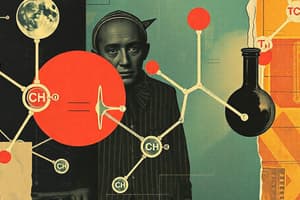Podcast
Questions and Answers
What are ions and how are they formed?
What are ions and how are they formed?
Ions are charged particles formed when atoms lose or gain electrons.
Explain the difference between cations and anions with examples.
Explain the difference between cations and anions with examples.
Cations are positive ions formed when atoms lose electrons, such as Na+, while anions are negative ions formed when atoms gain electrons, like Cl-.
Describe the process by which elements in groups 1, 2, and 3 form ions.
Describe the process by which elements in groups 1, 2, and 3 form ions.
Elements in groups 1, 2, and 3 lose their outer shell electrons to form positive ions with charges of 1+, 2+, or 3+.
What electron change occurs in elements of groups 5, 6, and 7 to form ions?
What electron change occurs in elements of groups 5, 6, and 7 to form ions?
Illustrate the formation of an aluminum ion from an aluminum atom.
Illustrate the formation of an aluminum ion from an aluminum atom.
What is the primary characteristic of ionic bonding?
What is the primary characteristic of ionic bonding?
How does the transfer of electrons occur in ionic bonding?
How does the transfer of electrons occur in ionic bonding?
What happens to sodium and chlorine atoms during ionic bonding?
What happens to sodium and chlorine atoms during ionic bonding?
In the provided diagram, how many electrons does the sodium atom have?
In the provided diagram, how many electrons does the sodium atom have?
Explain the significance of proton numbers in ionic bonding.
Explain the significance of proton numbers in ionic bonding.
Flashcards are hidden until you start studying
Study Notes
Ionic Bonding
- Ionic bonding involves a strong attraction between oppositely charged ions formed by the transfer of electrons.
- Example compounds include Sodium Chloride (NaCl) and Magnesium Oxide (MgO), comprising metals and non-metals.
- A metal loses electrons creating a positive ion (cation), while a non-metal gains electrons to form a negative ion (anion).
Transferring Electrons
- In reactions, metals (e.g., Sodium) lose electrons, while non-metals (e.g., Chlorine) gain them.
- The charged particles formed are ions: positive ions (e.g., Na+) and negative ions (e.g., Cl-).
- Elements in Groups 1, 2, and 3 typically lose electrons to form positive ions (1+, 2+, 3+).
- Elements in Groups 5, 6, and 7 gain electrons to form negative ions (3-, 2-, 1-).
Ion Formation
- Group Charge examples:
- Group 1: Na+ (1+)
- Group 2: Mg2+ (2+)
- Group 3: Al3+ (3+)
- Group 5: N3- (3-)
- Group 6: O2- (2-)
- Group 7: Br- (1-)
- All metals form positive ions; the ion’s charge indication shows how many electrons are lost.
Example Compounds
- Sodium Oxide (Na2O): Two Na+ ions combine with one O2- ion to balance charges.
- Barium Lead Nitrate (Ba(NO3)2): Barium (Ba2+) pairs with two nitrate ions (NO3-) to achieve charge balance.
Covalent Bonding
- Covalent bonding is characterized by strong electrostatic attractions between shared electrons and atomic nuclei.
- Covalent bonds are illustrated through dot and cross diagrams; for example, two hydrogen atoms share an electron pair.
- Diatomic molecules contain only two atoms, like H2.
Multiple Covalent Bonds
- Oxygen atoms share electrons to achieve stable configurations, forming double bonds (O=O) with two shared pairs.
- Carbon can form four covalent bonds by sharing its four outer shell electrons with other atoms (e.g., CH4 or methane).
Covalent Bonding Structure
- In methane (CH4), carbon shares electrons with four hydrogen atoms, achieving octet stability.
- Strong electrostatic forces hold together positive ions and delocalized electrons in metals.
- Metals exhibit malleability (can be shaped) and ductility (can be drawn into wires) due to their bonding structure.
Studying That Suits You
Use AI to generate personalized quizzes and flashcards to suit your learning preferences.




